|
|

 Embassy of the Dominican Republic
Embassy of the Dominican Republic
Tel:
202-332-6280
Fax: 202-265-8057

|
|
|
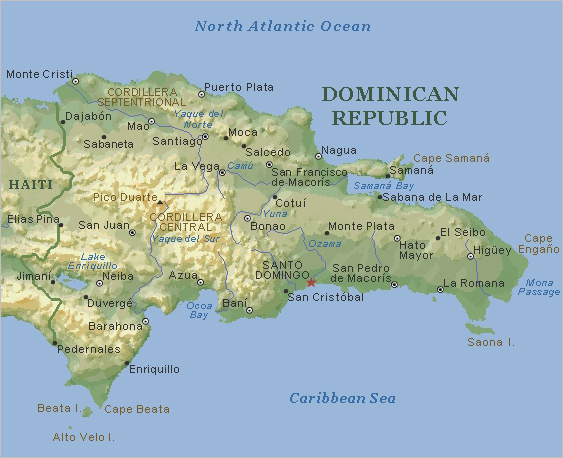
1. General Information
| Capital | Santo Domingo de Guzman |
| Population | 8,950,034 (2005) |
| Geo. Coordinates | 19 00 N, 70 40 W |
| Area | 48,442 Km². |
| Currency | Dominican peso |
| Independence | February 27, 1844 |
| Government | Democratic Republic |
| Official Language | Spanish |
| Official Religion | Roman Catholic |
| National Bird | “Cigua Palmera” |
| National Flower | Flor de la Caoba |
| President | Dr. Leonel A. Fernández R. |
| Vice President | Dr. Rafael Alburquerque |
2. Geography
The second largest nation in the Caribbean with a 48,442 Km² territory, Dominican Republic occupies the eastern two-thirds of the island of Santo Domingo (also called Hispaniola) in the Greater Antilles. It’s situated in the heart of the Caribbean region, between the Atlantic Ocean at north and Caribbean Sea at south. Jamaica rests at southwest; Puerto Rico is at east beyond the 70-mile Mona Passage; the Southern most tip of Florida is 685 miles away.
Four almost parallel mountain ranges, covered with thick vegetation, cross the country from east to west. The largest is the Cordillera Central, which divides the republic into almost equal parts. The highest peak in the Antilles, Pico Duarte (10,206 feet), is in this range. In the north is the Cordillera Septentrional and in the south is the Sierra Bahoruco.
The Valley of the Cibao (in native language means land between mountains), located between the Cordillera Central and the Cordillera Septentrional, is the largest and most important valley due to the agricultural activity that takes place in the region. Columbus named the area The Vega Real (Royal Plain) and it is often referred to as the “Garden of the Antilles”. It is the island’s granary, producing fruits, vegetables, and sugar cane. Its grassy savannas afford excellent pasturage.
The capital city, Santo Domingo, is located on the southern coast. The humid eastern section of this region contains large forests and savannas, while the western half is mostly dry and arid. It is in this region where the Lago Enriquillo (Lake Enriquillo) is located. It is a salt water lake below sea level. This zone is rich in salt, bauxite and marble.
The Republic’s second city and learning center is in Santiago, in the Cibao plain. This city situated on a high bluff on the Yaque Del Norte River, was founded in 1500.
The Dominican Republic has severals seaports, including Punta Caucedo, Santo Domingo, Haina, La Romana, San Pedro de Macorís, Puerto Plata, and Monte Cristi.
3. Culture
The first permanent colony of Europeans in the western hemisphere was established in the Dominican Republic. Santo Domingo, founded in 1496 by the brother of Christopher Columbus, was the first permanent city in the New World. Some of the old colonial buildings are still standing, fine examples of which are in Santo Domingo. The colonial center of Santo Domingo was declared a UNESCO World Heritage Site in 1990.
The UNESCO proclaimed in 2005 the Cocolo Dancing a Masterpiece of the Oral and Intangible Heritage of Humanity. The Cocolo dancing drama tradition developed among Carribean English-speaking migrant workers, who came to the Dominican Republic in the mid-nineteenth century. The term Cocolo was originally a pejorative term for migrants working on the British sugar plantations of the island. These migrants set up their own churches, schools, benevolent societies and lodges providing mutual assistance and organizing collective cultural events, such as the annual performances of the Cocolo Dancing Drama in the city of San Pedro de Macoris.
Art, music, and literature developed in part along Western patterns, with a strong African cultural component. The African heritage is especially notable in the country’s folk culture, particularly the music. The two traditions—African and Spanish—blend in the popular national song and dance, the merengue. Merengue music can be heard everywhere on the island, and every summer Santo Domingo holds a two-week merengue festival at which the world’s finest merengue bands and merengue dancers appear.
Most of the country’s major cultural institutions are in Santo Domingo. They include the Museo de las Casas Reales (Museum of the Royal Houses), a museum of colonial life; the Museo del Hombre Dominicano (Museum of the Dominican Man), with exhibits on pre-Columbian life on the island; and the Museo de Arte Moderna (Museum of Modern Art), with works by Dominican artists. The National Aquarium and National Botanical Garden, also in Santo Domingo, feature impressive displays. Puerto Plata on the north coast of the island has the Museo de Ámbar, which displays unusual pieces of Dominican amber with plants and insects and other animals embedded inside them.
Among the country’s most beloved writers is Salomé Ureña de Henríquez, who is considered a national poet. She lived in the second half of the 1800s and in 1881 organized the Instituto de Señoritas, the first Dominican center of higher education for women. Her two sons, Pedro and Max Henríquez-Ureña, became distinguished Latin American writers and thinkers. Other Dominican writers include Gastón Fernando Deligne, a modernist poet of the late 1800s and early 1900s; Fabio Fiallo, author of delicate love lyrics in the early 1900s; Manuel de Jesús Galván, author of Enriquillo (1882), a historical novel based on an early Native American revolt against the Spaniards; and Manuel del Cabral, a versatile 20th-century poet whose work showed his strong sympathies with the country’s impoverished blacks.
Juan Bosch, president of the republic in 1963, was also the most distinguished Dominican writer of the mid-20th century, well known as a novelist, short-story writer, and essayist. Joaquín Balaguer, the republic’s president from 1986 to 1996, was also an accomplished writer on many topics. Much of the best-known Dominican writing today comes from Dominicans who have emigrated. Julia Alvarez, who moved with her family from the Dominican Republic to New York City at the age of 10, has written about the collision of the two cultures in such works as the novel How the Garcia Girls Lost Their Accents (1991) and the children’s book How Tía Lola Came to Stay (2001).
For more information go to: www.dominicanaonline.org
4. History
In essence, Santo Domingo's history is the history of the Europeanization of the Americas. It is a history of conquest, revolution, and ultimately of the triumph of the human spirit.
Before the arrival of Christopher Columbus in 1492, the Taíno Indians populated the island of Hispaniola, including the part now occupied by the Dominican Republic. At that time, a chieftain or cacique ruled the island through a complex, centralized government, a fact completely lost on the Europeans, who dismissed the natives as "savages." The Taíno civilization effectively ended on October 12, 1492, with the arrival of Christopher Columbus, who declared Hispaniola "the most beautiful land that human eyes have ever seen."
Bartholomew Columbus, brother of Christopher Columbus, founded Santo Domingo, which is today the oldest European city founded by Europeans in the New World. In reality the city dates back to 1496, the period when the first Europeans settled there, although officially it was founded on August 5, 1498. Remnants of the original city can still be seen today throughout the Colonial Zone, which was declared a World Cultural Patrimony by UNESCO in 1994. This Colonial Zone section, bordered by the Río Ozama, has an impressive collection of 16th-century buildings, including palatial houses and majestic churches that reflect the architectural style of the late medieval period.
The city's most important colonial buildings include the Catedral Primada de America, which is the first Catholic Cathedral in the New World; the Alcázar de Colón, once the residence of Don Diego Colón, the son of Christopher Columbus who became viceroy of the colony; the Monasterio de San Francisco, the ruins of the first monastery in the Americas; the Museo de las Casas Reales, the former Palace of the Governor General and the Palace of Royal Audiences; the Parque Colón, a historic square; the Fortaleza Ozama, the oldest fortress in the New World; the Panteón Nacional, a former Jesuit now hosting the remains of various renown Dominicans; and the Iglesia del Convento Dominico, the first convent in the Americas.
Throughout its first century, Santo Domingo was the launching pad for much of the exploration and conquest of the New World. The expeditions that led to Ponce de Leon's "discovery" of Puerto Rico, Hernan Cortes' conquest of Mexico and Balboa's sighting of the Pacific Ocean all started from Santo Domingo.
In 1568, the famous English pirate Francis Drake invaded and pillaged the Hispaniola. This so weakened Spanish dominion over the island that for more than 50 years all but the capital was abandoned and left to the mercy of the pirates. In 1655, the French invaded the west end of the Island, and after several treaties and forced annexations, the portion of the island controlled by Santo Domingo was reduced to less than half. Later on, in 1822, the Haitians, commanded by Toussaint Louverture, took over the entire island, and the island's Spanish-speaking residents had to fight for their lost independence. Finally, on February 27, 1844, the Spanish part of the island regained its independence after 22 years of Haitian rule thanks to a group of patriots headed by Juan Pablo Duarte , Francisco del Rosario Sánchez and Ramón Matías Mella, being the Puerta del Conde the main scenario of this relevant event. It was then when the Spanish part of the island became the country known today as the Dominican Republic.
After the independence was achieved, various political factions struggled for control of Santo Domingo. In addition to this instability, the country had to fight continuous Haitian incursions, which were in their totality defeated. In 1861, the Spanish returned to Santo Domingo and annexed the country for four years, this period is known as the “Anexión a España”. After that, Santo Domingo went through many power changes, including the 20th-century Trujillo dictatorship (established after the 1916-1924 occupation by US Marines), which lasted from 1930 to 1961 and ended with the execution of the dictator; as well as the multiple presidencies of Joaquin Balaguer, who governed the country for 22 years. These civil wars and political struggles marked the first 70 years of the country's independence.
The year 1992 marked the 500th anniversary, El Quinto Centenario, of Christopher Columbus' opening of the Americas to European colonization. The Columbus Lighthouse (Faro de Colón), with an approximate cost of 400 million Dominican pesos, was erected, amidst great controversy, in honor of this occasion.
There are some museums dedicated to the history of the Dominican Republic, the Museo de las Casas Reales is dedicated to the colonial period; while the soon-to-be renovated Museo de Historia y Geografía independence is summarized in the Museo y Casa de Duarte and the Altar de la Patria.
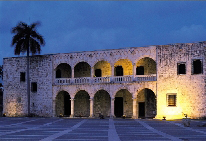
Alcazar de Colon | 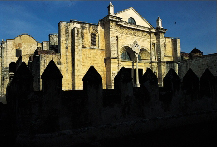
Cathedral of the Americas |
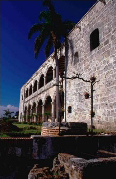
Alcazar de Colon | 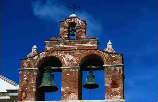
Detail of the Bell Tower of the Cathedral Of the Americas, Colonial Zone, Santo Domingo |
5. Government
www.presidencia.gov.do
Country Name:
Conventional long form: Dominican Republic
conventional short form: The Dominican
local long form: República Dominicana
local short form: La Dominicana
Government Type:
Representative Democracy
Administrative Divisions:
31 provinces : Azua, Baoruco, Barahona, Dajabón, Duarte, El Seibo, Elías Pina, Espaillat, Hato Mayor, Independencia, La Altagracia, La Romana, La Vega, Maria Trinidad Sánchez, Monseñor Nouel, Monte Cristi, Monte Plata, Pedernales, Peravia, Puerto Plata, Salcedo, Samaná, San Cristóbal, San José de Ocoa, San Juan, San Pedro de Macorís, Sánchez Ramírez, Santiago, Santiago Rodríguez, Santo Domingo, Valverde
1 District: National District
Independence:
27 February 1844 (from Haiti)
National Holiday:
Independence Day, 27 February (1844)
Constitution:
28 November 1966; amended 25 July 2002
Legal System:
Based on French civil codes; Criminal Procedures Code modified in 2004 to include important elements of an accusatory system; accepts compulsory ICJ jurisdiction
Suffrage:
18 years of age, universal and compulsory; married persons regardless of age
note: members of the armed forces and national police cannot vote
Executive Branch:
Chief of State: President Leonel Fernandez Reyna (since 16 August 2004); Vice President Rafael Alburquerque de Castro (since 16 August 2004); note - the president is both the chief of state and head of government.
Head of government: President Leonel Fernandez Reyna (since 16 August 2004); Vice President Rafael Alburquerque de Castro (since 16 August 2004).
Cabinet: Cabinet nominated by the president.
Elections: president and vice president elected on the same ticket by popular vote for four-year terms (eligible for a second term); election last held 16 May 2004 (next to be held in May 2008)
Election results: Leonel Fernandez elected president; percent of vote - Leonel Fernandez (PLD) 57.1%, Rafael Hipolito Mejia Dominguez (PRD) 33.7%, Eduardo Estrella (PRSC) 8.7%.
Legislative Branch:
Bicameral National Congress or Congreso Nacional consists of the Senate or Senado (32 seats; members are elected by popular vote to serve four-year terms) and the House of Representatives or Camara de Diputados (150 seats; members are elected by popular vote to serve four-year terms)
elections: Senate and House of Representatives last election May 2007.
Judicial Branch
Supreme Court or Corte Suprema (judges are appointed by the National Judicial Council comprised of the president, the leaders of both chambers of congress, the president of the Supreme Court, and an additional non-governing party congressional representative)
Political Parties:
The main political parties in the Dominican Republic are the Social Christian Reformist Party (PRSC), the Dominican Liberation Party (PLD) and the Dominican Revolutionary Party (PRD).
6. Economy
The Dominican Republic is a Caribbean representative democracy that enjoyed strong GDP growth until 2003. Although the country has long been viewed primarily as an exporter of sugar, coffee, and tobacco, in recent years the service sector has overtaken agriculture as the economy's largest employer due to growth in tourism and free trade zones. Growth turned negative in 2003 with reduced tourism, a major bank fraud, and limited growth in the US economy (the source of about 80% of export revenues), but recovered in 2004 and 2005.
With the help of strict fiscal targets agreed in the 2004 renegotiation of an IMF standby loan, President Fernandez has stabilized the country's financial situation. Although the economy continues to grow at a respectable rate, unemployment remains an important challenge. The country suffers from marked income inequality; the poorest half of the population receives less than one-fifth of GNP, while the richest 10% enjoys nearly 40% of national income. The Dominican Republic's development prospects improved with the ratification of the Central America-Dominican Republic Free Trade Agreement (CAFTA-DR) in September 2005.
7. Baseball
Whether it's little, minor or major league, baseball has been dominating the U.S. sports industry for decades. However, before legends like Babe Ruth and Jackie Robinson appeared in the spotlight, the Caribbean was flooded with pro-level players batting, throwing, catching and running the bases.
Back in 1866, American sailors stationed on the Island of Cuba taught natives the rules of the game of baseball. Following the Ten Years' War (also known as the Big War) in Cuba, baseball migrated to the Dominican Republic along with Cubans who were fleeing their country. Quickly nicknamed "beisbol" by the Dominican people, the sport was rapidly learned and became a passion. Today, traveling from one side of the country to the other presents national scores of baseball fields and stadiums, attesting to the Dominicans' love for the game.
The sport first turned competitive in the 1920s when baseball games began being played against neighboring countries. This competitiveness encouraged the establishment of the Dominican Baseball League. Four baseball teams were formed: Tigers del Licey and Leon del Escogido, both from Santo Domingo, Estrellas Orientals of San Pedro and the Las Aguilas in Santiago. The popularity of professional baseball in the Dominican Republic ascended throughout the following years, but came to a halt in 1937 due to a financial downturn in the country. Meanwhile, amateur baseball evolved with Dominican teams competing with those from the U.S. and other Caribbean countries. The hiatus finally ended in 1951 with the return of professional baseball. Dominicans' idea of hosting amateur baseball in the summer and professional baseball during the winter months was generated, therefore giving the Caribbean the "home of winter baseball" title.
Today there are two additional teams in the country's professional baseball league: the Azucareros del Este from La Romana and the Gigantes del Cibao. Each season extends from the end of October through February, with the winner advancing to the Caribbean Series. At the series, the winning team of the Dominican Republic league plays against the champions of the Mexican, Venezuelan and Puerto Rican leagues.
With the rich baseball history and top talent that the country provides, it's no surprise that American Major League Baseball (MLB) is drafting Dominican players left and right. In fact, according to MLB, more than 30 percent of contracted players come from Spanish-speaking nations and the numbers continue to rise. The first Dominican to play major league baseball in the United States was pitcher Ozzie Virgil, who joined the Detroit Tigers in 1958. Dominican pitcher Juan Marichal, who played for the San Francisco Giants, earned the nickname “Dandy Dominican” for his high leg kick. Although born in the United States, infielder Alex Rodriguez grew up in the Dominican Republic, where his father was a professional baseball player. Sammy Sosa was born in San Pedro de Macorís, which calls itself “The City Which Has Given the Most Major Leaguers to the World.”
Today MLB boasts 101 Dominican Republic players, Pedro Martinez and Jose Reyes of the NY Mets, of the Orioles Daniel Cabrera, Adrian Beltre of the Mariners, Albert Pujols of the St. Louis Cardinals, Vladimir Guerrero and Bartolo Colon of the Los Angeles Angels, Manny Ramirez and David Ortiz of the Boston Red Sox and Alfonso Soriano, Manny Acta of the Nationals.
To the Dominican people, baseball is not only a sport, but a way of life. Players here put heart and soul into the sport. While some players advance professionally into the United States, others continue to compete in the Dominican Republic, and countless more play for fun. But regardless of where the Dominicans play baseball, the sport will always be an admirable and historical part of the country's culture.
For more information go to www.republicofbaseball.com
8.Golf
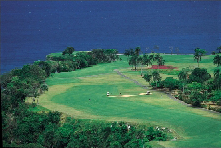 The Dominican Republic is one of the premier golf destinations in the Caribbean. Thanks to the tropical climate you're able to play all year around. Whether you are a golf pro or wish to embark on this fascinating sport in the Dominican Republic we make everything you need available to you in a selection of resorts next to or with their own golf course.
The Dominican Republic is one of the premier golf destinations in the Caribbean. Thanks to the tropical climate you're able to play all year around. Whether you are a golf pro or wish to embark on this fascinating sport in the Dominican Republic we make everything you need available to you in a selection of resorts next to or with their own golf course.
The majority of the golf courses are found along the coast in the country's burgeoning resorts, each with its own distinct identity, carefully designed with the coastline and hills incorporated. Over 20 courses are waiting for you to play on this tropical paradise and more promising courses are soon to be opened. Golf is one of the Dominican Republic's top attractions.
For more information go to www.golfguide-do.com
9.Flag
The Dominican Flag is divided into four sections separated by a white cross. The upper left section is dark blue; the lower left is red. On the right side of the cross the colors are reversed. The coat of arms appears in the center of the cross, and reads “God, Fatherland, and Liberty”.
10.Fauna
Large mammals were not known on Hispaniola due to its isolation over millions of years. Among the few mammals native of the island are bats, the bottlenose dolphin, Antillean Manatee (Trichechus manatus manatus) and two small land animals in danger of extinction, the solenodon and the hutia.
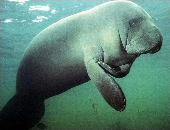 |
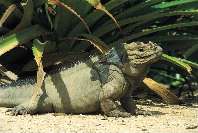 |
| Antillean Manatee |
Rhinoceros Iguana |
The Antillean Manatee and the Humpback Whales are two attractive, large sized mammals. The first one is almost extinct and the second stays every year, during three months (December/march) for its mating on the Bay of Samana In the northeastern part of the island.
Cow, pigs, donkeys and horses were all imported by the Spaniards. The European also brought mica, rats and cats on their ships. Mongooses, originally imported from India to combat the rats, have become a pest. Eighteen species of bats have been found in the country. Bird life is very rich on Hispaniola and 254 species (22 endemic) are known, about half of which live in the aquatic environment. Two indigenous birds that are now difficult to find are the Hispaniolan parrot and the perico.
Among the most famous local reptiles (1411 species with 83% of them endemic) are the American crocodile, the rhinoceros iguana and the ricard iguana. All three are endangered species but can often be seen in Isla Cabritos National Park. All snakes on the island are nonpoisonous. Frogs, mainly tree frogs, are abundant and can be quite noisy, living on palm and banana trees as well as telephone posts. Lizards are seen everywhere and 21 different species are known. The lizards all have in common a thin, often colorful skin along their throats, which is blown up like a balloon when they are threatened.
www.dominicanrepublic.com
11. Flora
The tropical climate of Hispaniola and the variations in elevations, rainfall and soil have produced a variety of plant habitats, ranging from dry areas to coniferous forests in the mountains. About 36% of the 5,600 plant species on the Island of Hispaniola are endemic.
The lush vegetation is found in the humid forests of the eastern mountain region. Local mahogany is abundant and was used in the construction of the first cathedral in 1540. Other native trees are the ceiba (silk cotton tree) known for its enormous size and long life (up to 300 years), Dominican magnolia, the bija and mammon tree. There are tree ferns and numerous bromeliad, orchids in the country’s forests, such as Sierra de Bahoruco National Park. Higher mountain zones are dominated by the creolcan pine tree, while the desert and semiarid areas dominated by cacti agaves terrain. For more information go to www.agricultura.gov.do
12. Natural Resources
The country abounds in gold and silver, amber, Larimer, ferronickel, bauxite, coal, tin, marble, salt, gypsum, limestone and gold.
13. Climate
Maritime tropical averaging 78 degrees Fahrenheit and ranging from 73 degrees in winter to 82 degrees in summer, the hottest month is August, the coolest is January. Trade winds keep the air cool and fresh; temperatures can drop up to 30 degrees in the mountains. Rains are more likely in May/June and August to October. Average monthly temperatures in the Dominican Republic (in degrees Fahrenheit) are as follows:
Tempertures in 2006
|
Jan |
Feb |
Mar |
Apr |
May |
Jun |
Jul |
Aug |
Sep |
Oct |
Nov |
Dec |
| Min |
68 |
66 |
67 |
69 |
71 |
72 |
72 |
73 |
72 |
72 |
70 |
69 |
| Max |
84 |
85 |
84 |
85 |
86 |
87 |
88 |
88 |
88 |
87 |
86 |
85 |
14. Major cities
The capital is Santo Domingo de Guzman, the oldest and largest city in the Caribbean with a land area of 144 square miles and a population of over 2.2 million (1990); Santiago de los Caballeros is second with 690,548; San Cristóbal 409,381; La Vega 335,140; Duarte 272,277; San Pedro de Macorís 212,886; Puerto Plata over 255,061; La Romana 158,132; La Altagracia (Higüey) 112,396; Samaná 49,537.
15. Museums
National museums celebrate all aspects of Dominican life in the past and present, as well as house treasures and artifacts from the world over. Among them are:
Santo Domingo:
Museum of Dominican Man
Museum of Natural History
Museum of Dominican Family
Museum of Royal Houses
Pre-hispanic Art Museum
Viceroy Museum and Alcazar
Museum of Antique Coins
Gallery of Modern Art
Coin Museum
Larimar Museum: www.larimarmuseum.com
Museo Alcazar de Diego Colon: www.rsta.pucmm.edu.do
Santiago:
Tomás Morel Folklore Museum
Cultural Center Eduardo León Jiménez
Puerto Plata:
Amber Museum
Altos de Chavón:
Archeological Museum
www.altosdechavon.com/fs_museum.htm
Shrine to Columbus
On October 6, 1992, Dominican Republic inaugurated the Columbus Lighthouse (El Faro a Colón), a towering modern structure carved as a cross which stands as a monument to the Great Admiral. On the same day, Columbus’ remains were transferred from the Santo Domingo Cathedral to a museum in this impressive monument serves as his final resting place.
For any further information: dir.museos@cultura.gov.do
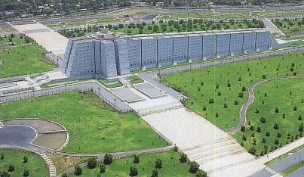 |
| Columbus Lighthouse |
The Columbus Lighthouse houses a dozen museums representing 500 years of history. Among those countries that have exhibit are the United Kingdom and Israel. The seven-story pyramid cross structure has 149 Xenon Skytrack Lasers that beam upward to project the image of a giant cross on the clouds.
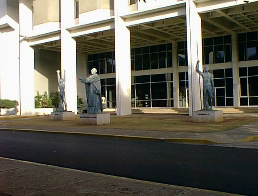 |
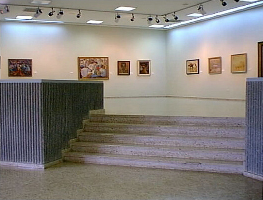 |
| Antillean Manatee |
Rhinoceros Iguana |
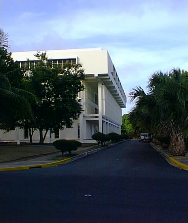 |
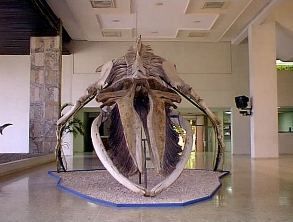 |
| Antillean Manatee |
Rhinoceros Iguana |
16. Language and Religion
Spanish is the official language of the Dominican Republic. English is widely spoken especially in tourist areas. Traffic signs and most menus in restaurants are in Spanish. A French dialect is heard along the Haitian frontier. Roman Catholicism is the dominant religion. There is a small Protestant community, and a small percentage of the people follow African animist religious beliefs
17. Education
The Dominican Republic provides free, compulsory education to children between the ages of 5 and 13. Some 85 percent of the population aged 15 or older is literate. In the 2000 school year 1.4 million pupils attended primary schools. While virtually all children attend primary school, only 59 percent of secondary school-aged children were enrolled.
The Autonomous University of Santo Domingo, the oldest university in the western hemisphere, was authorized in 1538, although classes did not begin until 1558. Four faculties were established, those of philosophy, medicine, theology, and jurisprudence, and the university attracted students from Mexico, Cuba, Venezuela, and elsewhere in Central America. The institution was originally called the Universidad de Santo Tomás de Aquino and was run by Dominican friars. It now occupies a modern campus known as University City.
The Catholic University Madre y Maestra was founded in Santiago in 1962. Other universities include Pedro Henríquez Ureña National University (1966) and Eugenio María de Hostos University (1981), both in Santo Domingo; Northeastern Catholic University (1978) in San Francisco de Macorís; and Central University of the East (1970) in San Pedro de Macorís. Art and music are taught in the national School of Fine Arts, and there is also a National Conservatory of Music.
18. Holidays in the Dominican Republic
| Jan. 1st. | New Year’s Day |
| Jan. 6th. | Epiphany |
| Jan. 21st. | Virgin Altagracia |
| Jan. 26th. | Birthday of Juan Pablo Duarte (Founding Father of the Nation) |
| Feb. 27th. | Independence Day |
| Variable | Good Friday |
| May. 1st. | Labor Day |
| Variable | Day of Corpus Christi |
| Aug. 16th. | Restoration of Independence |
| Sept. 24th. | Virgin Mercedes |
| Nov. 6th. | Constitution Day |
| Dec. 25th | Christmas Day |
|